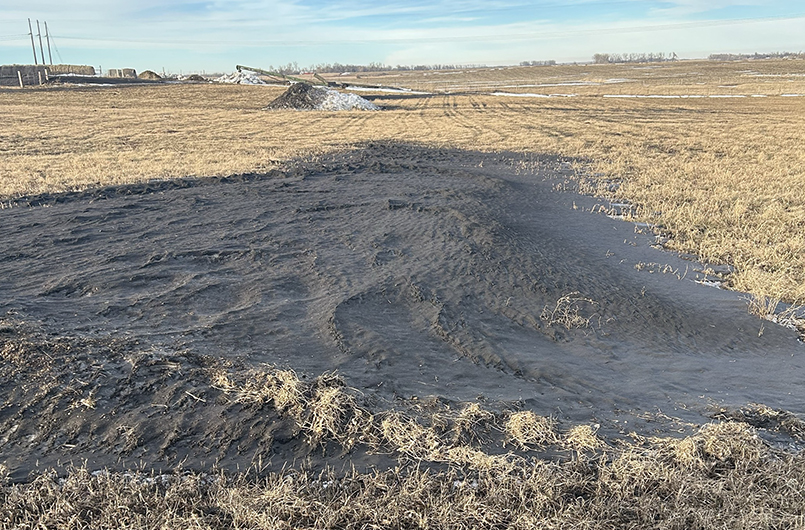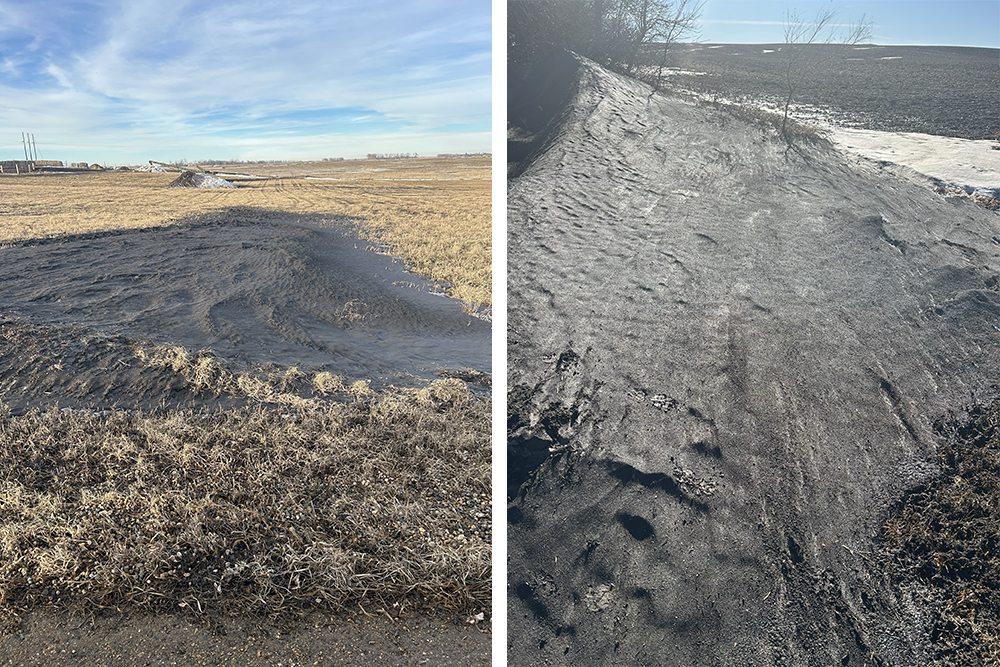
During these winter months, the AgSpire technical advisors and myself often work with farmers to help address a common issue: soil erosion.
Click here to read about the critical role that cover crops play to combat soil erosion >>>
When visiting farms in the Northern Plains and across the Midwest, it is common to see what is referred to as snirt. This is the combination of snow and dirt that accumulate in ditches during the snowy winter months in northern latitudes. Not having the soil armored during the winter allows for topsoil to be eroded from the fields and transported anywhere downwind, including ditches.

These pictures are of a snow drift near my house in eastern South Dakota. Much of the soil came off a field that had soybeans on it last year and will go to corn this spring. To prepare for the coming corn crop, it is most likely P (phosphorus) and K (potassium) were applied in the fall to give the field more nutrients before planting. Because of the fall application and the fallow soil, these nutrients have the potential to leave the field as soil erodes, ending up in the ditches instead.
Analyzing lost nutrients
To see how much fertility was being lost to erosion, I collected a soil sample from a snirt pile near my house. The soil sample analysis showed (full analysis at end of article):
> Very high range for P (31 ppm, weak bray), Mg (magnesium, 399 ppm), and Ca (calcium, 4133 ppm)
> Medium range for K, with 178 ppm
These are all nutrients that are being lost before a plant can ever utilize them. Not to mention, this lost topsoil is also the best regarding humus, organic matter, and CEC rating – making it critically important to best nurture a coming crop.
As the snow melts, what happens to these nutrients? Some will be utilized by the fauna in the ditch, while most of it will be washed into drainage systems and transported to water ways and eventually to the Gulf of Mexico.
The cost to producers
This lost fertility represents a huge loss to the farmer. Rough calculations show a yearly cost of nutrient loss per acre to be:
> Phosphorus: $196.80
> Potassium: $581.16
By simply multiplying the ppm number of P and K by two, we can calculate the lbs/acre for each of the nutrients from the soil report. We can then calculate the P and K fertilizer values with the lbs/acre lost from the soil sample. A ton of MAP (11-52-0) cash price is $820 with a ton of MOP (0-0-60) at $490 cash price. It takes 120 lbs of MAP/acre to equal 62 lbs p/acre while it will take 593 lbs mop/acre to equal 356 lbs k/acre. With these number we can calculate the field loss as $49.20 in P and $145.29 in K per acre in a three-month span. We can quadruple these number for a per acre yearly cost of nutrient loss.
These are just rough numbers from a single soil sample – but reveal the potential cost of these nutrients being blown off fallow fields every year. Soil erosion and degradation is a sneaky and leaky drain on producers’ financial well-being and the sustainability of our food system.
By following soil health principles, producers can significantly reduce the soil erosion in their operation and keep the most productive, valuable portion of a field in the field. It doesn’t matter if you look at soil erosion from an environmental point of view or an economical one – it doesn’t pencil out in the long run.

About the Author
Derek Ver Helst | Senior Conservation Agronomist
Derek holds a bachelor’s degree in Biology from South Dakota State University and a master’s degree in Agronomy from Iowa State University. He is a Certified Crop Advisor (CCA), Technical Service Provider (TSP) for the NRCS, and is also a small business owner. Prior to joining AgSpire, Derek spent more than 15 years working with landowners and corporations to design, manage, and validate research trials to maximize short- and long-term crop outputs.
 Visit AgSpire.com
Visit AgSpire.com